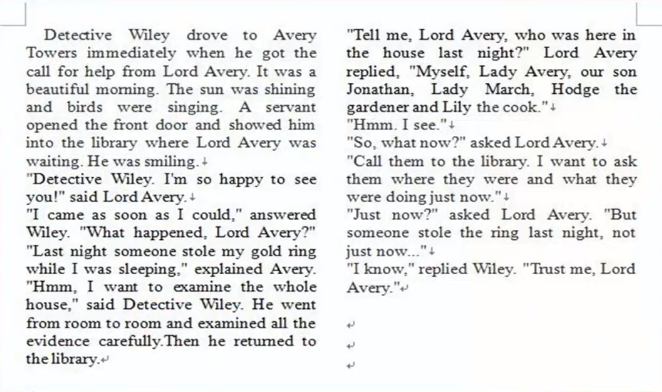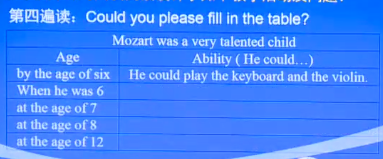阅读教学中问题设计的意义
教学问题设计的逻辑性(问题的角度、层次、问题之间的逻辑性(与阅读内容相关联的,相互联系的一体,要求由浅入深、严密的联系、环环相扣))直接影响学生思维能力的发展。亚里士多德:思维从问题、惊讶开始。
现状:
1.主线不清。2.缺乏层次性等逻辑问题
案例分析:
问题设计主线不清
Unit 4 Lesson 14 He was playing cards.
本课谈论的是侦探Wiley帮助Lord Avery侦破盗窃案的故事。学生通过阅读故事获取侦探Wiley为侦破案件所进行的一系列调查活动的信息,通过调查线索推断出谁是嫌疑犯。

本课教师针对三次阅读设计了如下教学活动及问题:
第一遍读: What does the story talk about?
第二 遍读: Who called Detective Wiley for help?
Where did Detective Wiley go?
When did Detective Wiley get there?
What happened to Lord Avery?
第三遍读: What did Detective Wiley do to find out the
suspect? Please read the rest of the story and number the
sentences in the correct order.
He wanted to ask them where they were and .…
He went from room to room and examined ... carefully.
He asked Lord Avery who was here in the house .…
分析:
教师,注意了整体阅读,引导学生了解故事大意“侦探Wiley帮助Lord Avery侦破盗窃案的故事”,事件中人物较多,教师并没有把握故事的主人公是Wiley,在获取信息的问题设
计中没有以主人公为主线继续进行设问,而是见信息就提问,看似符合记叙文的常规问题设计(who,where,when,what),但这四个问题并没有统一以侦探Wiley为主线进行设问。失
去了问题主线的逻辑性。
修改及建议:
When did the story happen? (On a beautiful morning.)
Where did it happen? (In Avery Towers.)
What happened at the beginning of the story? (Wiley got a call
for help from Avery.)
What did Wiley know at Avery's home? (Someone stole his
gold ring while Avery was sleeping.)
What did Wiley do in the house?
为了词汇学习而设计阅读问题:
Unit 4 Lesson 13 He could play the violin when he was six.
本课谈论莫扎特小时候的故事。通过阅读故事获取莫扎特小时候所会做事情的信息并猜测做这些事情的不同年龄。

本课教师针对四次阅读设计了如下教学活动及问题:
第一遍读: What's the passage mainly about?
第二遍读:Guess the age and check with the tape.
第三遍读: Which of the following is true?
When Mozart was six years old, he could play the violin.
When he was six, he could write music for the violin.
When he was seven, he could write a long piece of music.
When he was eight, he wrote operas.

分析及建议:
1.问题设计缺乏逻辑。猜测年龄后即可利用表格获取Mozart 不同年龄所能做的事,这样更符合逻辑顺序。判断正误,多为检测信息理解,应放在细节信息获取之后。
2.本课教师之所以把判断正误放在填写表格前面,只是单纯考虑可以借此处理生词keyboard,opera的理解。生词如talented,可
以通过后文事实为依据推测其含义,生词还可以在阅读过程中随着信息的提取进行词义理解,如:keyboard,在学生找到相关信息时,教师引导学生通过前后文进行推测。单独因为词汇处理而设计阅读问题势必影响阅读的正常逻辑顺序,同时还打断了阅读思路,不利于系统获取并理解阅读材料。
深层信息理解问题的设计缺乏层次性:
Unit 4 Lesson 16 They acted bravely.
本课谈论一对夫妇从火中救出一位老人的故事。通过阅读故事获取这对夫妇从火中救出老人过程的细节信息。

本课教师针对四次阅读设计了如下教学活动及问题:
第一遍读: What's the passage mainly about?
第二遍读: When and where did the story happen?
Who were the other characters?
What did the couple see when they were walking along the street?
What did they see and hear when they walked closer?
What did they do?
第三遍读: Which of the following is true?
The fire was on the second floor of the house.
The old man was shouting from the window.
The husband went for the ladder.
The husband carried the man down the ladder.
The husband called the emergency services.
The fire fighters thanked the husband and wife.
第四遍读:
What did firefighters think of the couple's action?
What does the husband think of what they did?
What do you think of them?
What can we learn from them?
分析:
教师设计了了解大意、获取和理解信息等问题。但故事深层次理解的问题设计缺乏由浅入深、由易到难的逻辑顺序。What did firefighters think of the couple's action? What does the husband think of what they
did?均是细节信息。本文需要引导学生通过阅读获取的主人公解救一位老人的具体行动,提炼出对这对夫妇品格的客观评价,以及引发思
考要向他们学习的品质或具体行为是什么,而不是消防队员对主人公的评价和主人公本人对自己的评价。
建议:
教师在设计问题时,应先从主人公解救老人的具体行为入手,哪些行为是给你留下深刻印象的,这些行为体现了主人公什么品质,主人公自我评价又体现了主人公的什么品质,最终引导学生内化阅读信息,表达自己应向主人公学
习的品质及行为,以及自己遇到一些突发事件会怎么做。
·本课最后的讨论环节,可以设计如下问题:
What things did the couple do to help the old man?
What gave you deep impression?
What do you think of their action?
What can we learn from the words "I don't think we did anything so special but it's nice to know that maybe you save a person's life."?
what will you do if you meet something like that?
1.依据故事主人公及事情发展顺序设计问题
记叙文中,人物往往不止一个,但一般是有主要人物,在引导学生阅读获取信息时,首先明确人物、时间、场所,确定以主人公所发生的事情为主线,来设计一系列问题引导学生阅读,使得阅读的思路清晰,脉络清楚,同时也符合学生的思维发展规律。
2.避免为单纯理解生词而设计问题
生词可以通过上下文或者句子本身推测其词性或词义。首先考虑主线,在信息获取及理解的同时适时地理解生词。
3.依据文中细节信息进行深层信息的问题设计。
每一篇故事都有其可挖掘的有意义的深层信息,如案例3的短文,可以挖掘主人公的品格,此外,还可透过文中的事实,推测故事的发展、结果等。而深层信息的挖掘一定要基于故
事中细节的支持,因此教师在设计深层信息理解的问题时,应考虑学生是否已经获取了足够的细节信息,并能够依据细节信息推断出深层的含义,这样才符合逻辑。


